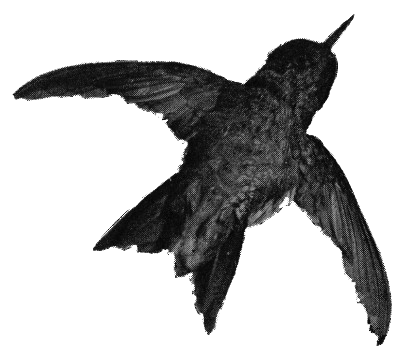| Web
and Book design,
Copyright, Kellscraft Studio 1999-2007 (Return to Web Text-ures) |
 (HOME)
|
|
CHAPTER II
THE RUBY-THROAT'S CATERERS 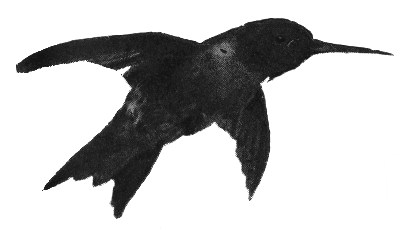 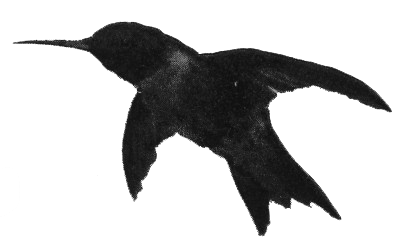 WHAT tempts the ruby-throated humming-bird to travel every spring from Central America as far north as the Arctic Circle, leaving behind him for a season those tropical delights so dear to four hun dred or more stay-at-home relatives while he, the sole representative of this charming New World family found east of the Mississippi and north of Florida, spends half his life among us in voluntary exile? How it stirs the imagination to picture the solitary, tiny migrant, a mere atom of bird life, moving above the range of human sight through the vast dome of sky, "lone wandering but not lost"! Borne swiftly onward by rapidly vibrating wings that measure barely two inches in length, he covers the thousands of miles between his winter home and his summer one by easy stages and arrives at his chosen destination, weather permitting, at approximately the same date year after year. Why does he come North? One of the
enlarging ideas gained through the study of Nature is that the same
primal
motives govern the actions of plant, bird, beast and man alike, — that
all
sentient beings act intelligently through the same strong, animating
desires,
their powers differing only in degree, not in kind. Naturally,
self-preservation and the favourable perpetuation of the species are
fundimental.
In tropical America, where vegetation is prodigal of bloom and insect life fairly teems, the ruby‑throat finds himself among a host of rivals for every drop of nectar secreted in the flowers and for every minute insect his tongue craves. But the competition for food, however keen, is no stronger than every creature requires to keep its faculties thoroughly alive. Presently even the luxuriant tropical vegetation takes a rest; insect life becomes dormant; there is not food enough for all, and hunger, the sharpest of spurs, begins to prick. How did the ruby-throat learn of our summer at the North, and that by following the course of the sun he might live in perpetual abundance? Doubtless his ancestors for ages back wandered farther and farther northward year by year in search of food, find‑ ing encouragement all the way; and through what scientists call the instinct of orientation, that is, the law of re‑ versed direction, traced their way back to the tropics even from Labrador. Stirred by the same impulse, intelligent merchants, closely pressed by competition in the great centres of trade at home, migrate to China or the Philippines, where they may have the whole field to themselves. 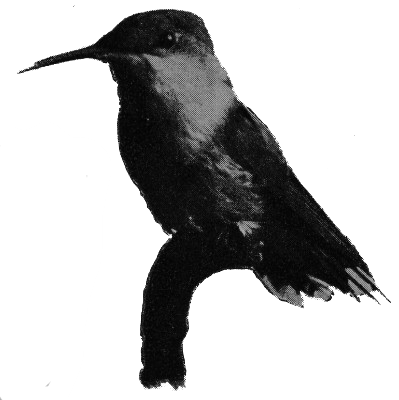 Before the coming of the Europeans to these shores with their imported trees, vines, shrubbery and flowering plants, what flowers in our area of Nature's garden undertook to feed the ruby-throat? It is true that almost any blossom which secretes nectar could be robbed by this little sprite. Nature always rewards the more highly developed of her struggling children by making the forms beneath them tributary to them. "All things are yours" was said to man alone. On such flowers as are easily drained by the mob of bees, wasps, moths and butterflies, the humming-bird wastes little time. Flowers like Jack-in-the-pulpit avowedly cater to gnats. Some, like the carrion- scented trillium allure flesh flies. The iris, gentian and many another blue or purple flower charm the more highly specialized bees by wearing what Sir John Lubbock proved to be their favourite colour. Butterflies delight in bright pinks especially, although there are few exclusive butterfly flowers. The night-flying moths come to the wooing of the twining white honeysuckle, tobacco plant, lily, moon-flower, evening primrose and a host of other white or yellow charmers, easily seen in the gloaming when brighter hues have faded into the prevail ing darkness, or detected from afar by their perfume. And so, if we could go through the entire list of flowers in our gardens and those growing wild, we should find that each is deliberately designed to attract, with special pleasing features, the insect or insects upon which it has become dependent for help in getting its pollen transferred from flower to flower. Self-pollination, we now clearly see, is one of the horrors of the vegetable kingdom; yet it was not until Darwin proved in countless experiments that cross-fertilization (pollen carried from one flower and placed upon the stigma of another) results in offspring which vanquish the offspring of self-fertilization in the struggle for existence, that the immense value of insect pollen carriers was understood. No wonder the flowers take infinite pains to entertain their insect benefactors and punish relentlessly the useless intruders! But certain flowers, it has been noticed, do not at tract insects; even the great bumble-bees, moths and butterflies, with very long tongues, cannot drain, by fair means, the columbine, for example. It is true that mischievous bees do occasionally bite holes through the tip of the columbine's horns of plenty, but it is evident that, since the flower receives no benefit from this rascally procedure, they cannot be legitimate guests. Large bumble-bees, however, doubtless pay their way. Flowers and insects form a mutual benefit co-operative association, in which there is not half so much pilfering done as in our business world. There must be quid pro quo or there is no trade in nature. Trespassing on the butterfly's preserves Finally, it was learned that just as there are fly, bee, beetle, wasp, butterfly and moth flowers, so there are flowers which avowedly cater to the humming-bird. He is an exacting little guest, demanding much of his entertainer who would in turn be served by him. First of all, he likes to have a vivid advertisement to attract his eye when he is flashing about through the sunshine in search of food. Some one once asked Eugene Field what was his favourite colour. "Why, I like any colour at all, so long as it's red," he replied — an answer which the ruby‑throat made to the flowers ages ago. It will be noticed that the blossoms which the bird monopolizes are either red or orange: possibly the latter please him for the sake of the red that was mixed with the yellow when their corollas were painted. 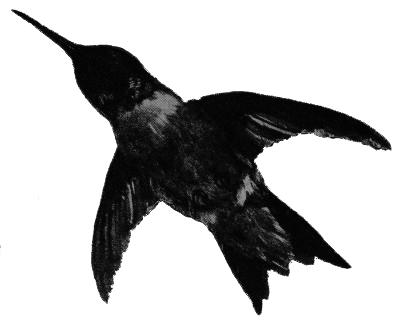 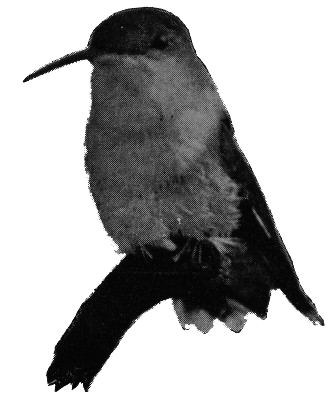 Such
flowers as
cater to insects must provide a landing place, a lip or flattened
platform of
some kind; but this the humming-bird, which sucks with his wings in
motion, of
course does not require. Nor does perfume appeal to him. Pathfinders to
the
nectary — little dark lines or patches of bright colour on the petals
such as
the bee likes to see on his flowers — the humming-bird may ignore. But
he does
demand that his red or orange flowers shall hide away their nectar in
deep
tubes, where the mob cannot drain them and where even his most
threatening
rivals, the larger bumble-bees, moths and butterflies, will find it
difficult
to extract. From the tip of his needle-like bill his tongue can he run
out at
will and turned in any direction to lick up the last drop of sweets in
a curved
cornucopia, whereas both bee and butterfly must insert their tongues in
a
straight line. Here he has great advantage over them. Again, he stipulates that the wild flowers which cater to him here shall bloom so as to feed him in orderly succession while it suits his convenience to remain away from the tropics, not to gorge him at one time and starve him at another. His visit in the vicinity of New York lasts from May to October.  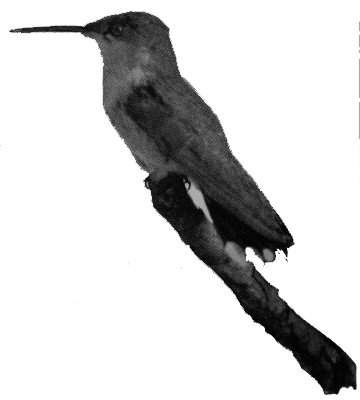 In the Southern States, through which he is passing in April, wooded hillsides and thickets are already gay with whorls of the coral honeysuckle's brilliant, slender, tubular flowers, flaunted from the tips of the branching vine where the dullest eye must be arrested by their beauty. Into these deep wells he plunges his bill and finds ample refreshment on his journey, especially when he adds to his menu some of the gauzy-winged little insects which have taken shelter from the spring winds within the orange-lined red trumpets. By carrying the ripe pollen shed from the anthers of one flower to the stigma of another, the ruby-throat pays the only price asked for his generous entertainment. Late in the season other larger birds on their way southward will bolt the bright berries on this vine and distribute the seeds over a wide area. It would, perhaps, be im possible to find another plant more wholly depend ent upon the ministration of birds than the coral honeysuckle. Small-flowered bush honeysuckles have adapted themselves to small bees; those with longer tubes and greater ambition strive to please bumble-bees; the twining honey suckle seen on every village porch wooes the sphinx-moth with white, deliciously sweet flowers, most fragrant at evening and which turn yellow after fertilization. Quite frequently the larger sphinx-moths are mistaken for humming-birds at gloaming when the former begin their rounds. It is true the ruby-throat often visits the moth's own flowers, but in the tubes of those which, like the twining honeysuckle, have newly opened at evening for their legitimate benefactors' benefit, the bird finds little left to reward his search the following day unless the previous evening has been too windy or rainy for the moths to fly. The coral honeysuckle's nectar cannot easily be reached by bees; its trumpets could not be seen after dark by the moths; moreover, it has no fragrance to guide them, but it pleases the ruby-throat in every essential respect. Draining the columbine's horns of plenty What is the next flower to spread his feast? With a broader and more northerly range than the coral honeysuckle's, the painted-cup or Indian paint-brush scatters its vivid scarlet tufts through the fresh green grass on meadow and prairie in May, its blooming season extending to July. Usually the first hummingbird of the season is seen suspended as if by magic over these glowing flakes of fire. In this species not the flowers themselves — for they are greenish yellow — but the floral bracts which enfold them are vermilion advertisements to catch the ruby-throat's eye. Other members of the figwort family, to which the painted-cup belongs, wear the bee's favourite colour and have provided a landing place on their lower lips for their benefactors; but here, what would be superfluous at the painted-cup's entrance, Nature has eliminated. Oswego tea Closely following the painted-cup, and indeed partly overlapping its season, comes the graceful, swinging, rock-loving columbine. Inasmuch as both these flowers rarely grow in the same neighbourhood, and as increased numbers of ruby throat migrants need to be fed at their blooming season, there is ample opportunity for both rivals to flourish. In the swollen tips of each of the five inverted red and yellow horns of plenty which go to make up a columbine, nectar is secreted. Small bees with their short tongues may well abandon hope of reaching it. Owing to the position of the flower, butterflies, which would have to place them selves upside down, could scarcely hold by their weak legs while sucking, and their tongues flex readily only when directed downward toward their bodies. Large bumble-bees, to which the shorter spurred blue wild columbine of Europe is perfectly adapted, find our species so difficult to drain that, rather than attempt the task, they too often nip holes in the nectaries, just as they do in the lark spurs, Dutchman's breeches, squirrel- corn, butter and eggs, jewel weed and other flowers which make dining too difficult for the clever rogues. But when the ruby throat whirrs up to the columbine, poising on rapidly vibrating wings before first one inverted horn, then another, until he circles the flower and drains each tube with ease, it will be seen that, in making this round, his forehead and bill must wipe off some of the pollen from the golden tassel of stamens which protrudes from the older flowers and that in visiting the newly opened columbines in the stigmatic stage, he must necessarily leave some of the vitalizing dust on them. Thus the columbine compels its chosen guest, all unwittingly, to do its bidding. 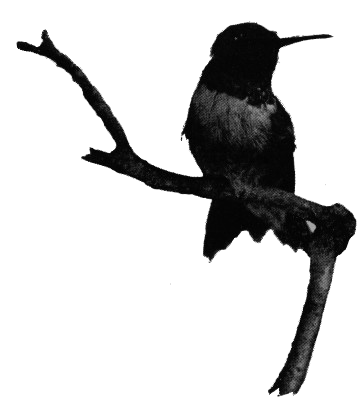 After the columbine has faded, which is the next flower to lure the ruby-throat? Exquisite bright orange-coloured and brown-speckled jewel-weed blossoms hanging at a horizontal from the tender plant which fringes our mill ponds, ditches and streams, appear in July, to last sparingly through the summer. The incurved, slender tip of their horns secrete nectar with whose overflow only the lusty, acrobatic bumble-bee must be content. To the abundant white pollen, however, he freely helps himself, and in so doing he may sometimes benefit his entertainer. But the humming-bird, charmed by the bright, graceful flower — and, indeed, who is not? — has no difficulty in directing his tongue around curves; and as he inserts his bill obliquely into the spur while he hovers above, the observer can easily see, on studying the jewel-weed's mechanism, how invaluable his services to it must be. This is one of the plants which bear also cleistogamous, or never opening, self-fertilized inconspicuous flowers. It has found its way into England, and Darwin recorded that there are twenty plants producing cleistogamous flowers there to one having the showy blossoms. Since there are no humming birds in Europe, why should the jewel-weed waste its energies? Bumble-bees can be its only benefactors there and they are not worth such expenditure. Cardinal flower Glowing
scarlet
heads of Oswego tea, bee balm or Indian plume, as it is variously
called, prove
to be next of kin to the scarlet salvia of our gardens, which comes
from the
tropics and which is there, as here, fertilized by the hummingbird.
Certainly,
the Indian plume's colour, form, mechanism and blooming season (from
July to
September) are as perfectly adapted as the salvia's to the ruby-throat,
a
constant visitor. Even the flower's protruding stamens, and quite
frequently
the bracts and upper leaves, wear his favourite colour. Where the
Indian plume
rears its rounded heads fringed with irregularly slender tubes beside
a
mountain stream, only the cardinal flower can vie with it in splendor. Everyone
who has a
trumpet creeper on the walls of his home knows how irresistibly
attractive to
the ruby-throat are its clusters of large, tawny red tubes outstretched
to hail
him. Occasionally the vine escapes from our gardens at the North, but
from New
Jersey to Illinois and southward to the Gulf it grows wild in Nature's
garden,
blooming in August and September. Flashing, whirring, darting about the
gorgeous flowers, their guest feasts with perfect satisfaction for do
they not
offer all he desires? Why should
the
exquisite cardinal flower deck itself in incomparable red while its
twin
sister, the great lobelia and its lesser kin wear blue? Watch the
contented
bees buzzing about the latter shorter tubed group and then the
ruby-throat
poised in ecstasy before the long-tubed cardinal flowers in September,
if you
would distinguish their true motives. How delighted must the humming-bird have been when we first added to our gardens — and his menu — his favourite salvias, cannas, nasturtiums, balsams, scarlet runner, fuschias, pelargoniums and gladioli, among many other welcome plants imported from warmer climes! These, while unnatural, un expected rivals to wild flowers which undertook to feed him, earn our threefold gratitude for bringing him to our very doors, causing his numbers to increase and prolonging his stay until frost blackens the once gay garden beds. Not till then does he leave them for the tropics. Young birds in the nest |
